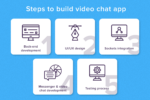- Developers
- Developer Blog
- Software Development
- How to Write a Product Requirements Document [Step-by-Step]

profile

By Aran Davies
Verified Expert
8 years of experience
Aran Davies is a full-stack software development engineer and tech writer with experience in Web and Mobile technologies. He is a tech nomad and has seen it all.
Are you wondering how to write a product requirements document?
The modern software product development process requires flawless communication between the management and the development/testing teams. A good product requirements document can be the difference between a successful product and one that misses the mark with end-users.
That brings up the question of what an effective product requirements document should look like and what it should contain.
If you’re a new product manager wondering how to write a product requirements document within the agile methodology parameters, keep reading.
In this article, I’ll explain how to write a product requirements document that clearly defines the functionality your product needs and how it fits within your agile software development roadmap.
Let’s get started.
What is a Product Requirements Document (PRD)?
Simply put, a product requirements document is a list of all the qualities, as well as usability and functional requirements that a product team needs to implement at various points during the product development process.
A PRD is often based on the company’s long-term product strategy, containing functional specifications for the entire lifecycle of the product.
Product owners and product managers come together with stakeholders to decide the exact specifications and capabilities. Once a comprehensive list of specs is finalized, the product manager arranges them in order of developmental hierarchy and importance and hands it over to the product development team in the form of a PRD.
It’s important to note that PRDs can be for both full versions and minimum viable products.

Get a complimentary discovery call and a free ballpark estimate for your project
Trusted by 100x of startups and companies like
The Difference Between a PRD and MRD
A product requirements document is often confused with a Marketing Requirements Document (MRD) in the product development sphere.
This is because they are similar in terms of their contents and the results they generate (i.e. show the development team what the final product needs to have and do).
However, in essence, the PRD and MRD are a little different in terms of how product stakeholders come up with their content.
A market requirements document is created by discovering market opportunities, collecting target customer demand data, investigating success metrics, and forecasting revenue.
In short, they are based on what the end-user has been found to want in a product, instead of what stakeholders desire from the product.
Most product business and technical teams develop an MRD before they move on to the direct product document. This is how PRDs are developed within a traditional Waterfall environment. Agile companies usually create both documents simultaneously and consolidate them before forwarding them to developers.
Write a Product Requirements Documents in these 7 Steps
Depending on the overall size and scope of the final software version, product management team members can create a comprehensive and effective product requirements document really easily.
They simply need to keep in mind the pain points of the end-users and create a stable baseline to build the documentation process on.
Here are the 7 steps to write the perfect product requirements document:
1. Clearly Describe the Goal(s) of Your Product
Product goals are the centerpiece of a PRD, simply because that’s the one metric that governs the majority of new product development runs.
Clearly described goals provide developers with an in-depth understanding of what the product is meant to accomplish in various timeframes.
When defining product goals, make sure that they are:
- Measurable, actionable, and achievable;
- Based on multiple use cases, created after detailed usage analysis;
- Built on end-customer needs;
- Beneficial to the company’s bottom line in the long run.
Additionally, make sure the goals are geared towards providing a solution to user problems, instead of addressing market gaps.
2. Identify User-Personas
Accurate user personas as a focal point are what separates a great product development run from one that fails to connect with audiences.
End-users are ideally the sole point of attention for both management and operations. In light of this, it pays to have a solid set of user personas, especially ones that lend themselves well to in-document a user story.
You can create on-point user personas by:
Hire expert developers for your next project
1,200 top developers
us since 2016
- Identifying the key demographics for your product;
- Discovering their key barriers or pain points;
- Analyzing use cases related to competitor products;
- Consolidating the data into a realistic persona model.
In addition to providing a target to build a product for, user personas allow product teams to prioritize the user experience in PRDs.
3. List and Describe Intended Product Features
The product feature list is the result of detailed market research and gap measurement, as well as in-depth customer analysis.
A clearly constructed and detailed product feature list serves as a direct guideline for the developers on how to initiate the development process and implement each feature in the product.
When listing the product features, make sure to:
- Describe the specific applications of each feature in detail;
- Justify each feature’s presence in the grand product scheme;
- Provide realistic use cases;
- Define the user-centric end goal of each feature.
You can discuss the potential complexity of each feature by having preliminary discussions with the developers on how viable the features are, considering developmental ability and resources.
4. Specify Success Metrics
While traditional success metrics are not as important as user experience and solution-based product development, the stakeholders need some encouragement to approve potentially successful products.
Describing positive key performance indicators to stakeholders is obviously useful. But, it’s necessary that your developers know which success metrics the product is meant to hit first, and to what extent.
In order to clearly specify success metrics, make sure to:
- Find out which metrics are essential for the short, intermediate, and long-term product success;
- Arrange metrics in order of importance;
- Research additional metrics via competitor analysis;
- Avoid any and all impractical metrics.
If your initial product was already successful, gather some of the KPIs from that run to determine which metrics you can replicate, and which don’t hold many benefits in the current iteration.
5. Specify Criteria for Release Readiness
Every software product goes through multiple reviews, dissections, and business-side circulations before it is released. Once it has cleared these, it is considered release-ready and pushed onto the development stage.
Setting clear release criteria for a complete PRD allows managers to add redundancy to the review process and get as many opinions on the products as possible before sending them off to development.
You can define the optimal criteria for release readiness by:
- Knowing product complexity via usage experience;
- Determining optimal release time frames by measuring demand;
- Counting the ideal number of pre-release testing cycles .
In theory, a release-ready PRD is considered an indicator of planning and theoretical product launch success.
6. Describe the User Flow and Create a Wireframe
A major part of testing the product is seeing how typical users would interact with it in a variety of use cases.
Creating a mockup or functional wireframe helps demonstrate the user workflow in real time while providing a low-fidelity but realistic model of the final product for UI tweaks.
When creating a product wireframe, consider:
Hire expert developers for your next project
- Prioritizing functionality over form;
- Leaving plenty of room for modification;
- Having successful use cases as a reference.
Additionally, hire a dedicated UI designer if possible to develop the wireframe. This ensures optimal user flow and fewer hiccups during user testing.
7. Highlight Your Constraints, Assumptions, and Dependencies
In the final stage of the document, mention how you expect end-users to interact with the product, add functional limits that you want the developers to know beforehand, and whether any dependencies exist in the developmental process.
These details will help developers optimize the product for the intended use pattern. Furthermore, it will aid developers with quicker implementation.
Product Requirement Document Templates
A good product requirements document template will help you take the guesswork out of setting up your PRD while also providing a platform for all future documentation.
Here are some of the top product requirements document example templates to build strong PRDs with:
- Atlassian: The Atlassian PRD template offers a clean and streamlined template for optimal product management experience.
- Slite: Another fundamental template, the PRD offering is optimized for remote management.
- UXPin: The UXPin template is more comprehensive, with examples and descriptions to help the documentation process along.
In case you’re looking to work on your first project as a product manager or owner, you can also create your own PRD template for future use. This will also be better if you need a custom template to suit your workforce or product specs.
However, considering the added value that comes with the aforementioned templates and others like them, it’s better to avoid unnecessary document errors and choose one of them.
Wrapping it Up
Once it’s past the prototyping stage, your product’s reputation will depend on which problems it solves for its intended users, that much is clear.
However, you can increase the chances of success by communicating the vision, motivation, and intended consequences behind the product as clearly and comprehensively as you can.
In conclusion, make sure that everyone involved in the product development is on the dedicated requirements management tool, knows what they are working towards in terms of quality and impact, and that your product documents reflect it. You can also use a dedicated requirements management tool in your organization for this purpose.
If you want help with product design and development, DevTeam.Space can help you via its field-exprt community of software developers and managers. You can partner with them by sending your initial project specifications. One of our account managers will get in touch with you.
Further Reading
Here are a few articles that might also interest you:
Interested in knowing how to build video a chat app? According to a study, "Video Conferencing Market is forecast to reach .65 billion by 2025, growing at a CAGR of 8.50% during 2020-2025". This shows that video chats apps have an...
Continue readingInterested in our vacation rental website builder guide? In this article What is a vacation rental? Examples of existing vacation-rental websites Features that a vacation rental website needs How to build a vacation rental...
Continue readingFAQS on How to Write a Product Requirements Document
A product requirements document defines the purpose, features, functionality, and behavior of a product.
Some requirements include reliability, availability, customer experience, performance, maintainability, etc.
A product requirements document should clearly outline the goals of the product, end users of the product, how users are expected to use product functionalities, etc.

Alexey Semeney
Founder of DevTeam.Space
Hire Alexey and His Team To Build a Great Product
Alexey is the founder of DevTeam.Space. He is award nominee among TOP 26 mentors of FI's 'Global Startup Mentor Awards'.
Alexey is Expert Startup Review Panel member and advices the oldest angel investment group in Silicon Valley on products investment deals.




